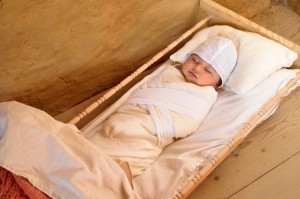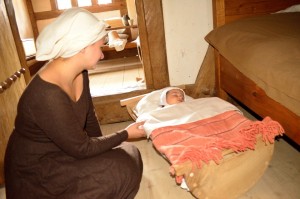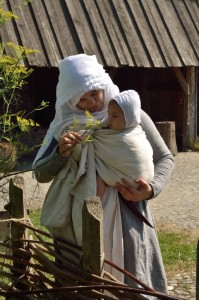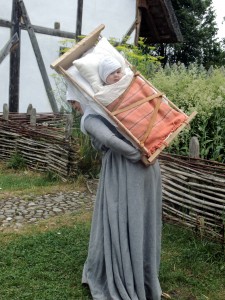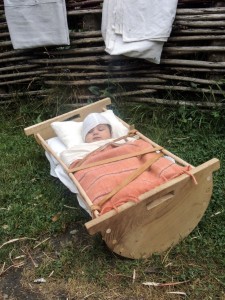Baby and Toddler care in medieval times
Compared to modern day ideas for babycare, actually a lot of parallels can be found in late medieval texts about the topic.
Shortly after birth, the baby needed to be swaddled, taking care that the arms and legs were in the “right” position since these – soft as wax as they were believed to be – would grow into the form given to them, which means that the wet nurse took a lot of influence on the later health of the child. Swaddled like that, the child was put into its cradle, the head warmly tucked in the sheets as well. (Aldobrandino of Siena, Regimen for the Body (1254))
The main nutrition for the baby in the first 1-3 years was mothersmilk, weaning was often led by the appearance of the first teeth, which enabled the child to eat normal food.
It was suggested to spread bitter essences like mustard or aloe on the breast as to make the baby stop sucking. The ideal of the nursing mother was held high in texts and art of the time, especially in the form of the nursing mother of Christ. It was suggested to adjust the nursing to the needs of the baby and give it the breast whenever it required. It was already understood that the first 6-8 months in the life of the child were distinctive for the later character.
While simple women were nursing their babies on their own breast, in late medieval times it was common for higher classes to give the baby to a wet nurse.
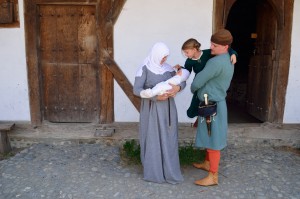
Since it was believed that the milk of the mother carried charakter qualities on to the child, it was very important to choose the right wet nurse. If the wet nurse was living with the family, she got more pay then if the family had to send the child outside of the house. The nurse was required to remain abstemious from sexual intercourse, if she became pregnant never the less, the child was taken from her and brought to another wet nurse, since it was believed that the baby would only get the “bad” nutrients from the nurses blood while the unborn child would get the best of the nurses blood.
Nursing mothers were advised to drink delicate wine, not heavy one. Wine was also given to children. Up until the 7th year of their lifes, they were advised to be given simple wine, depending on its strength, mixed with more or less water. White wine was supposed to be better than red wine. (Michele Savonarola, Ad mulieres ferrarienses (um 1450))
Since nursing is a rather safe contraceptive, the intervals between pregnancies in lower classes was usually larger than in higher classes.
Animal milk was usually not in use for nurturing babies except for emergency situations in orphanages where cow and goat milk was somethimes used, but the life expectancy of babies fed with this milk was very low.
After successfully weaning them, the baby got 3 meals a day, usually mash/porridge.
For their teething, it was suggested to massage the gums softly and treat them twice a day with rabbits brain, fat, butter or high value olive oil, dog’s milk or chicken fat. (Aldobrandino of Siena, Regimen for the Body (1254))
The first months of the baby’s life, after it woke up, it was suggested to by Francesco da Barberino in his “Reggimento e costumi di donna” to bath the child 2-3 times a day with handwarm or hot water, depending on the outside temperatures. Especially in winter, the bath would be done near the fire place. He suggested, not to let the skin become red or overheated and avoid to let the water get into the child’s ears.
The mother was encouraged to let the child tread water in the bath in order to let muscles build up. He even suggested to stretch the limbs of the child and oil the joints to avoid squeeking of the joints. The nose holes are also suggested to be oiled.
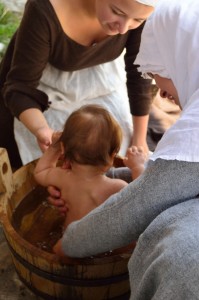
It was believed that the bones of the child were still very soft and needed to grow into their form which had to be supported by moving the limbs in the right direction.
After the bath, the child was wrapped in soft and if necessary prewarmed cloth.
The swaddling cloth – covering the whole body in the beginning – was seldomnly changed so abscesses and sores were normal for the baby.
The baby was sleeping in its cradle or in the bed of the parents or wet nurse. Contemporary writers were warning to be careful in order not to smother the child during the night.
The upringing throught the first months was very much adjusted to the child: Screaming was believed to be bad for the child and it was suggested to controll the swaddling cloth, the hold of the bandages and of course if the child might be hungry.
A child that was screaming a lot was believed by superstitious parts of the population to be a changeling. In trying to get the “real” child back, mothers were following rituals and practices, that were not seldomnly dangerous or deadly for the child. Among them pouring boiling water on it, casting the child out in the wilderness etc. In order to stop these practices, public authorities of the late middle ages were implementing sharp controls and sentences.
Concerning the physiological and psychological development of the child, it was suggested to respect the individuality of the child and not force it into sitting, walking and talking as long as it did not make its own attempts. Mother and nurse were advised to stimulate the child to new movements during play and baby walking devices and child seats were used to make the first steps easier. Until the 7th birthday, upbringing was in the hands of women.
Historical pictures on the topic of baby and toddler upbringing we collected for you here !
Sources (german mostly):
- Weber-Kellermann, Ingeborg (1997): Die Kindheit. Eine Kulturgeschichte. 1. Aufl. Frankfurt am Main: Insel-Verl (Insel-Taschenbuch, 1972)
- Melitta Weis-Amer: Medieval Women’s Guides to Food during Pregnancy: Origins, Texts, and Traditions*(PDF)
- Sandra Schmidt: Die Kindheit im Mittelalter (Universität Salzburg, SS1999, Institut für Geschichte)
- Kühnel, Harry; Hundsbichler, Helmut (1986): Alltag im Spätmittelalter. 2., verb. Darmstadt: Wiss. Buchges.
- Šaḥar, Šûlammît: Kindheit im Mittelalter. 1991, Artemis & Winkler Verlag: München.




